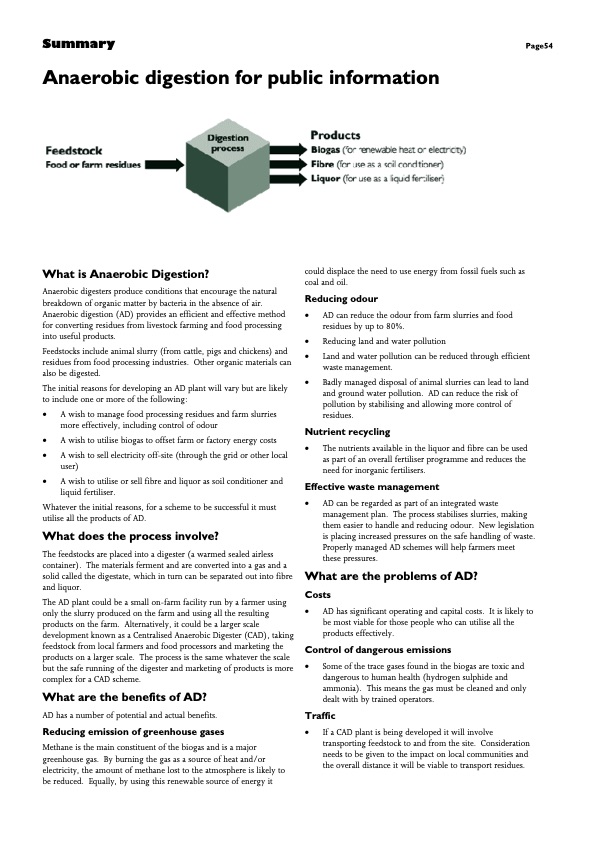
PDF Publication Title:
Text from PDF Page: 056
Summary Anaerobic digestion for public information Page54 What is Anaerobic Digestion? Anaerobic digesters produce conditions that encourage the natural breakdown of organic matter by bacteria in the absence of air. Anaerobic digestion (AD) provides an efficient and effective method for converting residues from livestock farming and food processing into useful products. Feedstocks include animal slurry (from cattle, pigs and chickens) and residues from food processing industries. Other organic materials can also be digested. The initial reasons for developing an AD plant will vary but are likely to include one or more of the following: • A wish to manage food processing residues and farm slurries more effectively, including control of odour • A wish to utilise biogas to offset farm or factory energy costs • A wish to sell electricity off-site (through the grid or other local user) • A wish to utilise or sell fibre and liquor as soil conditioner and liquid fertiliser. Whatever the initial reasons, for a scheme to be successful it must utilise all the products of AD. What does the process involve? The feedstocks are placed into a digester (a warmed sealed airless container). The materials ferment and are converted into a gas and a solid called the digestate, which in turn can be separated out into fibre and liquor. The AD plant could be a small on-farm facility run by a farmer using only the slurry produced on the farm and using all the resulting products on the farm. Alternatively, it could be a larger scale development known as a Centralised Anaerobic Digester (CAD), taking feedstock from local farmers and food processors and marketing the products on a larger scale. The process is the same whatever the scale but the safe running of the digester and marketing of products is more complex for a CAD scheme. could displace the need to use energy from fossil fuels such as coal and oil. Reducing odour • AD can reduce the odour from farm slurries and food residues by up to 80%. • Reducing land and water pollution • Land and water pollution can be reduced through efficient waste management. • Badly managed disposal of animal slurries can lead to land and ground water pollution. AD can reduce the risk of pollution by stabilising and allowing more control of residues. Nutrient recycling • The nutrients available in the liquor and fibre can be used as part of an overall fertiliser programme and reduces the need for inorganic fertilisers. Effective waste management • AD can be regarded as part of an integrated waste management plan. The process stabilises slurries, making them easier to handle and reducing odour. New legislation is placing increased pressures on the safe handling of waste. Properly managed AD schemes will help farmers meet these pressures. What are the problems of AD? Costs • AD has significant operating and capital costs. It is likely to be most viable for those people who can utilise all the products effectively. Control of dangerous emissions • Some of the trace gases found in the biogas are toxic and dangerous to human health (hydrogen sulphide and ammonia). This means the gas must be cleaned and only dealt with by trained operators. T raffic • If a CAD plant is being developed it will involve transporting feedstock to and from the site. Consideration needs to be given to the impact on local communities and the overall distance it will be viable to transport residues. What are the benefits of AD? AD has a number of potential and actual benefits. Reducing emission of greenhouse gases Methane is the main constituent of the biogas and is a major greenhouse gas. By burning the gas as a source of heat and/or electricity, the amount of methane lost to the atmosphere is likely to be reduced. Equally, by using this renewable source of energy itPDF Image | Anaerobic Digestion Of farm and food Processing residues The development of a sustainable industry

PDF Search Title:
Anaerobic Digestion Of farm and food Processing residues The development of a sustainable industryOriginal File Name Searched:
biogas10.pdfDIY PDF Search: Google It | Yahoo | Bing
Capstone Turbine and Microturbine: Capstone microturbines used and new surplus for sale listing More Info
Consulting and Strategy Services: Need help with Capstone Turbine, sizing systems, applications, or renewable energy strategy, we are here to assist More Info
Container Lumber Dry Kiln: Since 1991 developing and innovating dry kilns using standard shipping containers More Info
Supercritical CO2 Lumber Dry Kiln: Compact fast drying in 3 days or less for small amounts of wood and lumber drying More Info
BitCoin Mining: Bitcoin Mining and Cryptocurrency... More Info
Publications: Capstone Turbine publications for microturbine and distributed energy More Info
FileMaker Software for Renewable Energy Developing database software for the renewable energy industry More Info
CO2 Gas to Liquids On-Demand Production Cart Developing a supercritical CO2 to alcohol on-demand production system (via Nafion reverse fuel cell) More Info
Stranded Gas for low cost power Bitcoin Mining Using stranded gas for generators may provide breakthrough low power costs for cryptocurrency miners. More Info
| CONTACT TEL: 608-238-6001 Email: greg@globalmicroturbine.com | RSS | AMP |